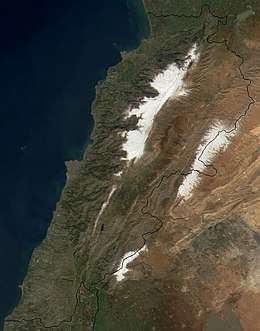International rankings of Lebanon
The following are international rankings of Lebanon.
Demographics
- United Nations: Population, ranked 124 out of 223 countries
- CIA World Factbook: Urbanization ranked 21 out of 193 countries[1]
Economy
- The Wall Street Journal and Heritage Foundation: Index of Economic Freedom 2009, ranked 95 out of 179 countries[2]
- World Bank: Ease of Doing Business Index 2009, ranked 99 out of 181 countries[3]
- International Monetary Fund: GDP per capita 2015, ranked 57 out of 179 countries
- World Bank: GDP per capita 2014, ranked 65 out of 170 countries [4]
- CIA World Factbook: GDP per capita 2013, ranked 67 out of 192 countries [5]
In the 2009 quality of life index, Lebanon ranked in the last place ( out of 194 countries )
Lebanon ranked in the 35th largest exporter of IT ICT enabled services among 173 countries
Education
Listed by the World Economic Forum's 2013 Global Information Technology Report, Lebanon has been ranked globally as the fourth best country for math and science education, and as the tenth best overall for quality of education.[6] In Quality of management schools, the country was ranked 131th worldwide.[7] These rankings are based on the Executive Opinion Survey, carried out as part of the WEF's Global Competitiveness Report, based on polling a sample of business leaders in each respective country.[8][9]
- United Nations gross enrolment ratio 2005, ranked 47 out of 177 countries[10]
- United Nations Development Programme: literacy rate 2007/2008, ranked 96 out of 177 countries [11]
Geography

- Total area ranked 166 out of 233 countries and outlying territories
- Renewable water resources ranked 145 out of 174 countries
Military
- CIA World Factbook: Military expenditures ranked 78 out of 171 countries
- CIA World Factbook: Military expenditures ratio to GDP, ranked 45 out of 174 countries [12]
Politics
- Transparency International: Corruption Perceptions Index 2007, ranked 99 out of 179 countries[13]
- Reporters Without Borders: Worldwide Press Freedom Index 2008, ranked 66 out of 173 countries
- The Economist EIU: Democracy Index 2008, ranked 89 out of 167 countries[14]
Tourism
Growth in tourism for 2009, Lebanon came first out of 165 countries examined by ( UNWTO ) with an increase of 60% from 2008.
Transportation
- Motor vehicles per capita ranked 23 out of 140 countries [15]
References
- CIA World Factbook, CIA
- Index of Economic Freedom 2009
- "Ease of Doing Business Index 2009".
- Data refer to the year 2008. Total GDP 2008 & Population 2008, World Development Indicators database, World Bank, July 1, 2009. Note: Per capita values were obtained by dividing the Total GDP data by the Population data.
- GDP (official exchange rate), The World Factbook, Central Intelligence Agency, last updated on April 23, 2009; accessed on April 25, 2009. Population data obtained from Total Midyear Population Archived 2013-10-12 at the Wayback Machine, US Census Bureau International Data Base, accessed on April 25, 2009. Note: Per capita values were obtained by dividing the GDP (official exchange rate) data by the Population data.
- Bilbao-Osorio, Benat; Dutta, Soumitra; Lanvin, Bruno, eds. (2013). "The Global Information Technology Report 2013: Growth and Jobs in a Hyperconnected World" (PDF). World Economic Forum. Geneva. pp. 324–325. Retrieved 5 February 2014.
- Bilbao-Osorio, Benat; Dutta, Soumitra; Lanvin, Bruno, eds. (2013). "The Global Information Technology Report 2013: Growth and Jobs in a Hyperconnected World" (PDF). World Economic Forum. Geneva. p. 311. Retrieved 5 February 2014.
- Bilbao-Osorio, Benat; Dutta, Soumitra; Lanvin, Bruno, eds. (2013). "The Global Information Technology Report 2013: Growth and Jobs in a Hyperconnected World" (PDF). World Economic Forum. Geneva. p. 289. Retrieved 5 February 2014.
- Schwab, Klaus; Sala-i-Martin, Xavier; Brende, Børge (2013). "The Global Competitiveness Report 2013-2014: Full Data Edition" (PDF). World Economic Forum. Geneva. pp. 83–85. Retrieved 5 February 2014.
- "Human development indicators Lebanon". United Nations Development Programme, Human Development Reports. Archived from the original on 2008-10-22. Retrieved 2008-11-17.{}
- Human Development Report 2007/2008 Table 1
- CIA World Factbook
- "Corruption Perception Report 2007". Archived from the original on 2006-06-19. Retrieved 2009-07-31.
- Index of Democracy 2008 Archived 2008-12-14 at the Wayback Machine (PDF) Economist Intelligence Unit
- Motor vehicles per capita